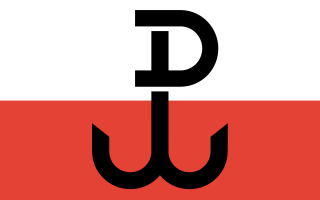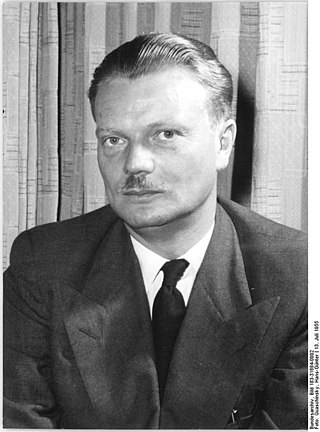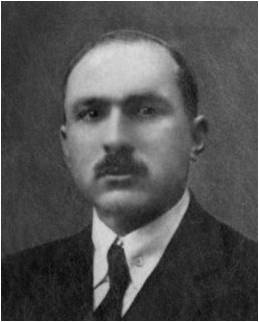
The Home Army was the dominant resistance movement in German-occupied Poland during World War II. The Home Army was formed in February 1942 from the earlier Związek Walki Zbrojnej established in the aftermath of the German and Soviet invasions in September 1939. Over the next two years, the Home Army absorbed most of the other Polish partisans and underground forces. Its allegiance was to the Polish government-in-exile in London, and it constituted the armed wing of what came to be known as the Polish Underground State. Estimates of the Home Army's 1944 strength range between 200,000 and 600,000. The latter number made the Home Army not only Poland's largest underground resistance movement but, along with Soviet and Yugoslav partisans, one of Europe's largest World War II underground movements.

Witold Pilecki was a Polish World War II cavalry officer, intelligence agent, and resistance leader.

The Polish Underground State[a] was a single political and military entity formed by the union of resistance organizations in occupied Poland that were loyal to the Government of the Republic of Poland in exile in London. The first elements of the Underground State were established in the final days of the German and Soviet invasion of Poland, in late September 1939. The Underground State was perceived by supporters as a legal continuation of the pre-war Republic of Poland that waged an armed struggle against the country's occupying powers: Nazi Germany and the Soviet Union. The Underground State encompassed not only military resistance, one of the largest in the world,[b] but also civilian structures, such as justice, education, culture and social services.

Biuletyn Informacyjny was a Polish underground weekly published covertly in General Government territory of occupied Poland during World War II. The magazine was edited by Aleksander Kamiński and distributed as the main organ of ZWZ-AK headquarters in Warsaw, initially in order to inform the AK soldier about ongoing resistance activities. By 1944 Biuletyn Informacyjny had a circulation of 42,000-43,000 copies. The publishers recommended readers to have the articles reprinted in provincial underground publications throughout Poland.

Peasant Battalions was a Polish resistance movement, guerrilla and partisan organisation, during World War II. The organisation was created in mid-1940 by the agrarian political party People's Party and by 1944 was partially integrated with the Armia Krajowa. At its height, in summer 1944 the organisation had 160,000 members.

The Union of Armed Struggle, also translated as the Union for Armed Struggle, Association of Armed Struggle, and Association for Armed Struggle, was an underground army formed in Poland following its invasion in September 1939 by Germany and the Soviet Union that opened World War II. It existed from 13 November 1939 until 14 February 1942, when it was renamed into Home Army.

Janusz Bokszczanin was a colonel of the Polish Army and one of the first Polish commanders of the motorized troops in the reborn Second Polish Republic. During World War II he joined the ZWZ resistance organization and later the Home Army. Until 1943 he served as chief of department of rapid response within its headquarters. In 1944, prior to the anti-Fascist Operation Tempest, he became the chief of operations, and deputy chief of staff of the entire Home Army (AK).

In Poland, the resistance movement during World War II was led by the Home Army. The Polish resistance is notable among others for disrupting German supply lines to the Eastern Front, and providing intelligence reports to the British intelligence agencies. It was a part of the Polish Underground State.

Union of Retaliation was a Polish World War II resistance organisation established on 20 April 1940. It was created by General Stefan Rowecki, head of the Armed Resistance, as that organization's branch dedicated to sabotage and covert operations.

Service for Poland's Victory, also translated as the Polish Victory Service, was the first Polish resistance movement in World War II. It was created by the order of general Juliusz Rómmel on 27 September 1939, when the siege of Warsaw, capital of Poland, where Rómmel commanded Polish defence, was nearing its end.

Bolesław Bogdan Piasecki, alias Leon Całka, Wojciech z Królewca, Sablewski was a Polish writer, politician and political theorist. During the war, he was active in the anti-German and anti-Soviet armed underground. Initially of national radical views, he became associated after the war with the ruling Polish communists and led a group of lay Catholics who collaborated with the communist regime.

Kazimierz Pużak (1883–1950) was a Polish socialist politician of the interwar period. Active in the Polish Socialist Party, he was one of the leaders of the Polish Secret State and Polish resistance, sentenced by the Soviets in the infamous Trial of the Sixteen in 1945.
The National Radical Camp was an ultranationalist and antisemitic political movement which existed in the pre-World War II Second Polish Republic, and an illegal Polish anti-communist, and nationalist political party formed on 14 April 1934 mostly by the youth radicals who left the National Party of the National Democracy movement.

Political Consultative Committee was the beginning of the political arm of the Polish Secret State in occupied Poland during World War II. It was formed on 26 February 1940 by several Polish political parties continuing their activities underground. The parties wanted to tighten the cooperation so that they could have more influence over the newly created Association of Armed Struggle (ZWZ) meant by the Polish government in exile as the main unified organization of the Polish resistance. In April 1940 the government in exile recognized the Committee as the country's political representation.

Organizacja Wojskowa Związek Jaszczurczy was an organization of Polish resistance in World War II. Created in 1939 and transformed into National Armed Forces in 1942, it represented the far right of the Polish political spectrum (related to the National Radical Camp political party. It refused to recognise the broadly internationally recognised Polish Government-in-exile, although there was some uneasy tactical cooperation for practical reasons. It and descendants also refused to recognise the Soviet-aligned Polish Committee of National Liberation and continued to resist the new Polish communist regime and the USSR after the war.

Halina Szwarcde domoKłąb (1923–2002) - was a member of the Polish resistance during the Second World War, working undercover first under the pseudonym Ryszard, then Jacek II. Postwar, she became a professor of medicine in gerontology, and in 1970/1971, the prorector of the Józef Piłsudski University of Physical Education in Warsaw.

"Siekiera, motyka" is a famous Polish Resistance military and street-level protest song from the period of World War II. It became the most popular song of occupied Warsaw, and then, of the entire occupied Poland. The song was inspired by an old humorous folk-tune performed already in 1917 with different and constantly changing lyrics, adapted for the army in a 1938 publication under a different title.

Franciszek Niepokólczycki alias Teodor, Szubert, Franek, Żejmian, Halny was a colonel of Polish Army. During World War II, commander of the Union of Retaliation, officer of the Union of Armed Struggle and the Kedyw of Home Army. President of the Freedom and Independence from 1945 to 1946 and political prisoner of the Stalinist period.

The organization of underground resistance movements in Auschwitz concentration camp began in the second half of 1940, shortly after the camp became operational in May that year. In September 1940 Witold Pilecki, a Polish army captain, arrived in the camp. Using the name Tomasz Serafiński, Pilecki had allowed himself to be captured by Germans in a street round up (łapanka) with the goal of having himself sent to Auschwitz to gather information and organize resistance inside. Under Pilecki's direction the Związek Organizacji Wojskowej, ZOW, was formed.

The "Falanga" officially the National-Radical Movement, was an illegal political organization formed as a result of a split by Boleslaw Piasecki in the National Radical Camp. Formed as a result of a split in the National Radical Camp. Active mainly at universities, propagating nationalist, anti-Semitic and pro-Catholic slogan. Since 1936 cooperated with the Camp of National Unity. Numbered about 5,000 members. During German occupation, Falanga's activities were continued by Confederation of the Nation.














